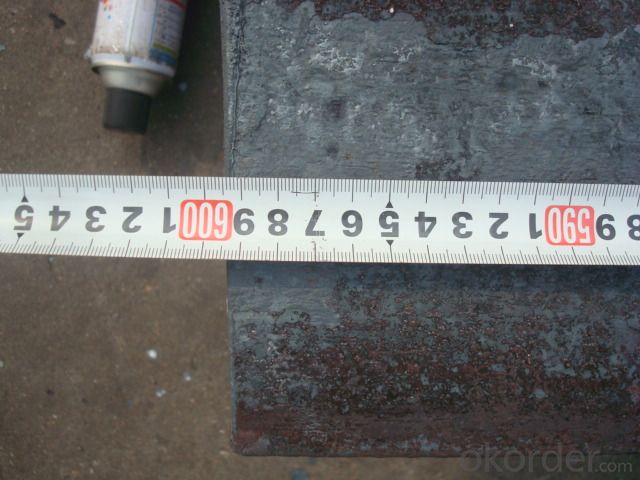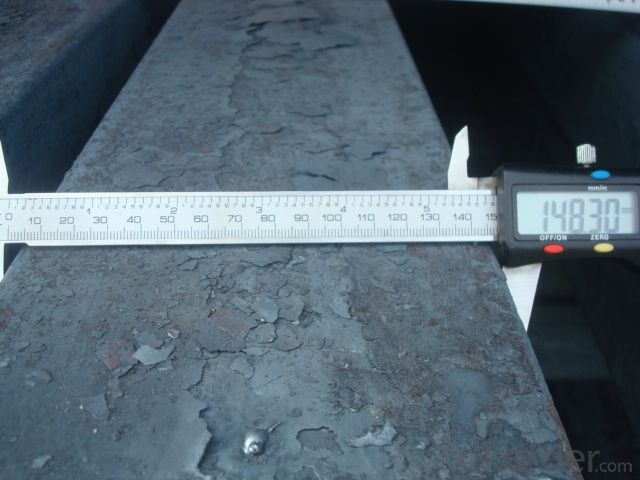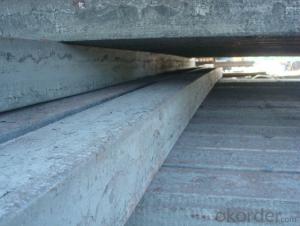Continuous Casting Steel Billet Q275 in Amazing Price
- Loading Port:
- Tianjin
- Payment Terms:
- TT OR LC
- Min Order Qty:
- 1000 m.t.
- Supply Capability:
- 200000 m.t./month
OKorder Service Pledge
OKorder Financial Service
You Might Also Like
STEEL BILLET
1.Structure of Steel Billet
Steel billet(ingot) by cogging or breakdown of semi-finished products, is the raw material of all kinds of steel mill. Billet section of square, round, flat, rectangular and abnormity of several kinds of, mainly related to the shape of rolled products.
2.Main Features of Steel Billet
Rectangular billet continuous casting billet and mainly general carbon steel, low carbon low silicon cold-rolled material, high quality carbon structural steel, high strength low alloy steel, special steel, etc.
The billet is mainly divided into two kinds from the shape:
Slab: cross section width and height of the ratio of the larger, mainly used for rolling plate.
Billet: equal cross section width and height, or a huge difference, mainly used for rolling steel, wire rod. ,
Steel billets have distinct characteristics as compared with already furnished steel bars and products. Billets have a specific grain structure, which enables the metal to be processed more intricately. Steel billets are also known for their malleability and ductility, especially when exposed to varying temperatures during shaping and molding.
3.Processing of Steel Billet
Steel billets are considered fresh and raw, and they must undergo a series of manufacturing processes before they can be used for various purposes. Billets are made by means of freezing molten liquid, and are later exposed to extremely low temperatures in order to allow the metal to take shape and solidify in chemical structure. The temperature manipulates the metal's physical properties, and tones its strength and durability. The subsequent processes provide the metal's curved mold design so that it can fit the allotted space provided by other machines, which complete the finishing procedures.
4.Steel Billet Images


5.Usage of Steel Billet
Billets, or ingots (as they sometimes referred to), are not of practical use until they have been formed into more functional shapes and sizes. While they have already been put in the furnace, they still require a series of shaping and molding procedures such as hot and cold working, milling and cutting before they are sold in hardware stores, or used for different applications. The unformed billets, however, can be used in striking currency such as coins and as reserves, similar to gold bars.
6. Steel Billet Specification
Hot rolled billet steel
Size: 50x50mm-180x180mm
Steel Grade: 3SP, 5SP,Q195,Q235,Q255,Q275 Length:3m-12m
MOQ: 1000MT/size
Payment term: TT or LC
Packing: in bulk , bundle
Shipment: by container , bulk vessel
Packaging Details: bundles with steel strips or as customers's requirements
Delivery time: 15-30 days after the deposit
Loading port:Tianjin, or other port China
Origin :China
Inspection:Third party inspection before loading.
7.FAQ
We have organized several common questions for our clients,may help you sincerely:
1) How about your company?
A world class manufacturer & supplier of castings forging in carbon steel and alloy steel,is one of the large-scale professional investment casting production bases in China,consisting of both casting foundry forging and machining factory. Annually more than 8000 tons Precision casting and forging parts are exported to markets in Europe,America and Japan. OEM casting and forging service available according to customer’s requirements.
2) How to guarantee the quality of the products?
We have established the international advanced quality management system,every link from raw material to final product we have strict quality test;We resolutely put an end to unqualified products flowing into the market. At the same time, we will provide necessary follow-up service assurance.
3) How long can we receive the product after purchase?
In the purchase of product within three working days, We will arrange the factory delivery as soon as possible. The pecific time of receiving is related to the state and position of customers.Commonly 7 to 10 working days can be served.
4)Do you have your own QC department?
Yes, we have, our QC department will inspect the goods during the process of mass production and after completion of production.
5)If there’s something wrong with the quality of the products, how do we return the goods?
We promise you the quality will be the same as the samples you confirmed. If there’s something wrong with the quality of the products, please send back sample from the shipment goods to us and let us know the quantity, then we will investigate in our work shop. If it is our problem, we will offer you discount or replacements for free.
- Q:How are steel billets priced in the market?
- Steel billets are typically priced in the market based on various factors such as supply and demand dynamics, production costs, and market conditions. The pricing is influenced by factors such as raw material costs, energy prices, transportation costs, and any applicable taxes or duties. Additionally, market participants consider factors like global economic trends, industry forecasts, and geopolitical events that may impact the overall steel market. Ultimately, steel billet pricing is determined through negotiations between buyers and sellers based on these various factors.
- Q:Can steel billets be used in the production of appliances?
- Appliances can indeed utilize steel billets for their production. These semi-finished products are typically employed for subsequent processing into diverse forms and dimensions. In the context of appliances, steel billets can serve as the primary material for fabricating elements like frames, panels, and other structural components. Steel possesses remarkable versatility and durability, providing robustness, stability, and corrosion resistance, thereby rendering it appropriate for appliances requiring sturdy construction. Moreover, steel can be effortlessly molded and shaped to fulfill the distinct design requisites of various appliances, making it the preferred choice in the manufacturing procedure.
- Q:What are the different types of steel billet surface defects?
- During the manufacturing process, various steel billet surface defects may arise. These defects have the potential to impact the steel's quality and performance, thus necessitating their identification and resolution to safeguard the final product's integrity. 1. Scale: Oxidation during heating and rolling gives rise to a widespread defect known as scale. This defect manifests as a thin layer of iron oxide on the billet's surface, which can be readily eliminated through descaling procedures. 2. Cracks: Another common defect is cracks, which can emerge on the billet's surface. These cracks can be caused by factors such as uneven cooling, excessive stress, or improper handling. Due to their ability to compromise structural integrity, cracked billets necessitate repair or disposal. 3. Pitting: Pitting is characterized by shallow depressions or pits on the billet's surface. It can arise due to impurities in the steel, inadequate cooling, or corrosion. Pitting diminishes strength and heightens susceptibility to corrosion. 4. Lamination: Lamination defects occur when the billet experiences poor bonding during manufacturing, leading to the presence of layers or separation. This defect undermines the steel's mechanical properties, potentially resulting in failure under stress. 5. Inclusions: Non-metallic substances, such as slag, oxides, or other impurities, can become trapped within the billet during manufacturing, causing inclusions. Inclusions weaken the steel and decrease its ductility, rendering it more prone to cracking or breaking. 6. Scratches: Superficial defects like scratches may arise during billet handling or transportation. While they may not significantly impact overall structural integrity, they can concentrate stress in localized areas, potentially leading to failure in specific applications. 7. Decarburization: Decarburization occurs when the billet's surface loses its carbon content during the heating process. This defect reduces hardness and strength in the affected region, impacting the steel's performance. Manufacturers and inspectors must possess knowledge of these various steel billet surface defects to ensure the production of high-quality steel products. Regular inspections, quality control measures, and appropriate corrective actions are vital in minimizing and addressing these defects, thereby guaranteeing the desired steel performance and longevity.
- Q:What are the different types of tests conducted on steel billets?
- There are several different types of tests that are conducted on steel billets to ensure their quality and suitability for various applications. These tests are essential in determining the mechanical properties, chemical composition, and integrity of the steel billets. 1. Chemical Composition Analysis: This test involves examining the chemical composition of the steel billets to ensure that they meet the required standards and specifications. It measures the levels of various elements such as carbon, manganese, silicon, sulfur, and phosphorus. 2. Tensile Test: This test measures the tensile strength, yield strength, and elongation of the steel billets. It helps determine the ability of the steel to withstand pulling forces without breaking. 3. Hardness Test: This test determines the hardness of the steel billets, which is essential in evaluating their resistance to wear, deformation, and penetration. Commonly used hardness tests include Brinell, Rockwell, and Vickers tests. 4. Impact Test: This test measures the toughness and ability of the steel billets to absorb energy under impact or sudden loading conditions. It helps determine their resistance to fracture and cracking. 5. Ultrasonic Testing: This non-destructive test uses high-frequency sound waves to detect internal flaws or defects in the steel billets. It is commonly used to detect cracks, voids, and inclusions that may affect the structural integrity of the billets. 6. Dimensional Inspection: This test ensures that the steel billets meet the specified dimensional requirements, including length, width, and thickness. It ensures that the billets are suitable for their intended application and can be used in subsequent manufacturing processes without any issues. 7. Macroscopic Examination: This visual inspection involves examining the surface and internal structure of the steel billets using magnification. It helps identify any visible defects such as cracks, porosity, segregation, or any other irregularities. 8. Microscopic Examination: This test involves examining the microstructure of the steel billets using a microscope. It helps determine the grain size, presence of phases, and any abnormalities in the steel structure that may affect its properties. These tests collectively ensure that the steel billets meet the required quality standards and possess the necessary mechanical properties for their intended applications. They help ensure the safety, reliability, and performance of the steel billets in various industries such as construction, automotive, aerospace, and manufacturing.
- Q:What are the potential applications of steel billets in the automotive industry?
- Steel billets have a wide range of potential applications in the automotive industry. They can be used in the production of various components such as engine parts, chassis, suspension systems, and body panels. Steel billets offer excellent strength, durability, and high melting points, making them ideal for ensuring the safety and reliability of vehicles. Additionally, their versatility allows for customization and lightweight designs, contributing to improved fuel efficiency and overall performance.
- Q:What does "billet" mean?
- Steelmaking and continuous casting of steel products are mainly used for steel rolling, such as round bar, wire rod, sheet metal and so on
- Q:Are there any alternative materials to steel billets in certain applications?
- Yes, there are several alternative materials to steel billets in certain applications. Some commonly used alternatives include aluminum billets, copper billets, and titanium billets. Each of these materials possesses unique properties and characteristics that make them suitable for specific applications where steel may not be the most ideal choice. For example, aluminum billets are lightweight and have excellent corrosion resistance, making them suitable for industries such as aerospace and automotive. Copper billets are known for their superior electrical conductivity, making them commonly used in electrical and electronic applications. Titanium billets offer exceptional strength, low density, and high heat resistance, making them suitable for industries such as aerospace, military, and medical. Ultimately, the choice of alternative material depends on the specific requirements and demands of the application in question.
- Q:How are steel billets used in the production of construction components?
- Steel billets are an intermediate product used in the production of construction components. They are typically heated and then shaped into various forms such as beams, columns, or rods, which are essential for constructing buildings, bridges, and other structures.
- Q:What are the main factors affecting the corrosion resistance of steel billets?
- The main factors affecting the corrosion resistance of steel billets include the composition of the steel, presence of impurities, environmental conditions (such as humidity and temperature), exposure to corrosive substances, surface finish, and protective coatings.
- Q:How are steel billets used in the production of hydraulic components?
- Hydraulic components production heavily relies on steel billets, which serve as an essential raw material. These semi-finished steel forms act as the initial step in manufacturing various hydraulic parts. To commence, steel billets are subjected to high temperatures to enhance their malleability. This process, known as hot rolling, facilitates easy shaping and formation of the billets into the desired hydraulic component. Subsequently, the heated billets are passed through a series of rollers, resulting in the desired size and shape, such as bars, rods, or tubes. After shaping, the steel billets undergo further machining procedures to fabricate specific hydraulic components. For instance, they may be cut, drilled, or threaded to create pistons, cylinders, valve bodies, or other essential parts utilized in hydraulic systems. The utilization of steel billets in hydraulic component production offers numerous advantages. Firstly, steel is renowned for its strength and durability, making it an ideal material for hydraulic applications where components endure high pressure and heavy loads. Additionally, steel's exceptional corrosion resistance ensures the longevity of hydraulic components, even in harsh operating conditions. Moreover, steel billets facilitate precise dimensional control throughout the manufacturing process. This guarantees that the hydraulic components meet the required specifications and can flawlessly integrate into hydraulic systems, without compromising performance. In conclusion, steel billets play a pivotal role in hydraulic component production. By commencing with these semi-finished steel forms, manufacturers can fabricate high-quality, durable, and precisely engineered parts, which are crucial for the efficient functioning of hydraulic systems.
1. Manufacturer Overview |
|
|---|---|
| Location | |
| Year Established | |
| Annual Output Value | |
| Main Markets | |
| Company Certifications | |
2. Manufacturer Certificates |
|
|---|---|
| a) Certification Name | |
| Range | |
| Reference | |
| Validity Period | |
3. Manufacturer Capability |
|
|---|---|
| a)Trade Capacity | |
| Nearest Port | |
| Export Percentage | |
| No.of Employees in Trade Department | |
| Language Spoken: | |
| b)Factory Information | |
| Factory Size: | |
| No. of Production Lines | |
| Contract Manufacturing | |
| Product Price Range | |
Send your message to us
Continuous Casting Steel Billet Q275 in Amazing Price
- Loading Port:
- Tianjin
- Payment Terms:
- TT OR LC
- Min Order Qty:
- 1000 m.t.
- Supply Capability:
- 200000 m.t./month
OKorder Service Pledge
OKorder Financial Service
Similar products
New products
Hot products
Related keywords





























